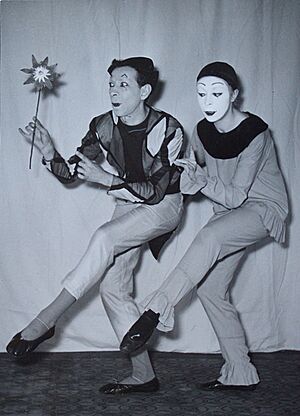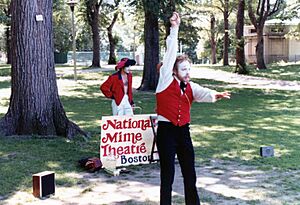Mime artist facts for kids
A mime artist is a performer who tells a story using only body movements. They do not use speech. This art form is called mime or pantomime. In the past, these performers were sometimes called "mummers." Mime is different from silent comedy. In silent comedy, characters act without sound in a film or skit.
Famous theatre teachers like Jacques Copeau and Étienne Decroux helped develop modern mime. They were inspired by old theatre styles. For example, they looked at Commedia dell'arte from Italy and Noh theatre from Japan. Jacques Lecoq also greatly helped mime and physical theatre grow. Because of these efforts, mime is now recognized as an important cultural heritage in France.
Contents
History of Mime
Ancient Roots
Mime performances began a very long time ago in Ancient Greece. The word "mime" comes from a Greek word meaning "imitator" or "actor." Early mime often involved a single masked dancer. The first known mime was Telestēs in a play by Aeschylus.
Mime also became popular in Ancient Rome. It was different from other plays because performers did not wear masks. Also, both women and men could be mime artists. Some Roman emperors liked mime, while others did not. Even Emperor Nero performed as a mime!
Mime in Medieval Europe
During the Middle Ages in Europe, early forms of mime appeared. These included "mummer plays" and "dumbshows." Later, in the 1800s, a French artist named Jean-Gaspard Deburau helped create the modern mime look. He was known for his silent character with a white painted face.
Mime Around the World
Similar types of performances exist in other cultures too. In Classical Indian musical theatre, performers tell stories with special gestures. They use hand positions and mime illusions to show different characters and actions. Sometimes, music and singing go along with the performance. The ancient Indian book Natya Shastra even talks about silent acting.
In Japanese Noh theatre, performers use masks and very physical movements. This style has influenced many modern mime artists. Another Japanese art form, Butoh, also uses movement to tell stories.
Different Ways Mime is Performed
Mime in Movies

Before the 1900s, there weren't many books explaining mime. So, we mostly guess how it was performed long ago. But the 20th century brought movies! Early movies had little or no talking. Stories had to be told mostly through actions. This made mime very important in films before "talkies" (movies with sound) came along.
Famous silent film comedians like Charlie Chaplin, Harold Lloyd, and Buster Keaton were great mime artists. They learned their skills in theatre. Their movies had a huge impact on mime for many years. Chaplin is probably the most famous mime in history.
Even after sound films, some artists continued mime. Harpo Marx from the Marx Brothers comedy team was a silent character. He was a funny contrast to his talking brothers. The French director Jacques Tati also started as a mime. His films had very little talking. Instead, they used clever visual jokes and expertly planned movements.
Mime on Stage and Streets
Mime is often performed on stage. Marcel Marceau and his famous character "Bip" are well-known examples. Mime is also popular in street theatre and busking. Traditionally, these performers wear tight black and white clothes. They also paint their faces white.
However, many modern mimes do not use white face paint. While traditional mimes were completely silent, some modern mimes make sounds. They still avoid speaking words. Mime acts can be very funny, but some can also be very serious.
List of Mime Artists
- Samuel Avital
- Steven Banks
- Jean-Louis Barrault
- Blue Man Group
- Wolfe Bowart
- Tony Brown
- Charlie Chaplin
- Michel Courtemanche
- Adam Darius
- Jean-Gaspard Deburau
- Étienne Decroux
- Ryan Drummond
- Jogesh Dutta
- Ladislav Fialka
- Dario Fo
- George L. Fox
- Chris Harris
- Bill Irwin
- Alejandro Jodorowsky
- Doug Jones
- Buster Keaton
- Lindsay Kemp
- Stan Laurel
- Thomas Leabhart
- Grigory Gurevich
- Jacques Lecoq
- Paul Legrand
- Tina Lenert
- Partha Pratim Majumder
- Marcel Marceau
- Ennio Marchetto
- Kari Margolis
- Carlos Martínez
- Harpo Marx
- Irene Mawer
- Samy Molcho
- Tony Montanaro
- Mummenschanz
- Stefan Niedziałkowski
- Adrian Pecknold
- Lenka Pichlíková-Burke
- Slava Polunin
- Oleg Popov
- Nola Rae
- Bari Rolfe
- Gene Sheldon
- Richmond Shepard
- Shields and Yarnell
- Red Skelton
- Steam Powered Giraffe
- Daniel Stein
- Marko Stojanović
- Jacques Tati
- Pan Tau
- Modris Tenisons
- Tik and Tok
- Henryk Tomaszewski
- Dick Van Dyke
- Sam Wills
- Vahram Zaryan
- Achille Zavatta
- Benedikt Negro
See also
 In Spanish: Mimo para niños
In Spanish: Mimo para niños
- Busking
- Corporeal mime
- Dumbshow
- Lip sync
- Liquid and digits
- Sociae Mimae
- Mummers play
- Pantomime
- Popping
- Physical theatre
- Turfing



